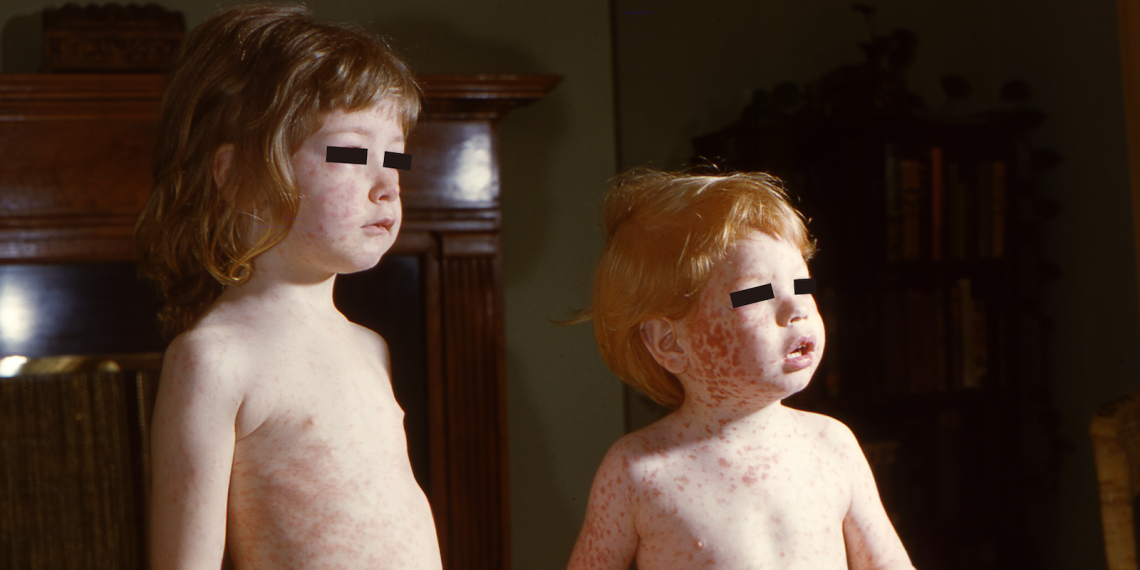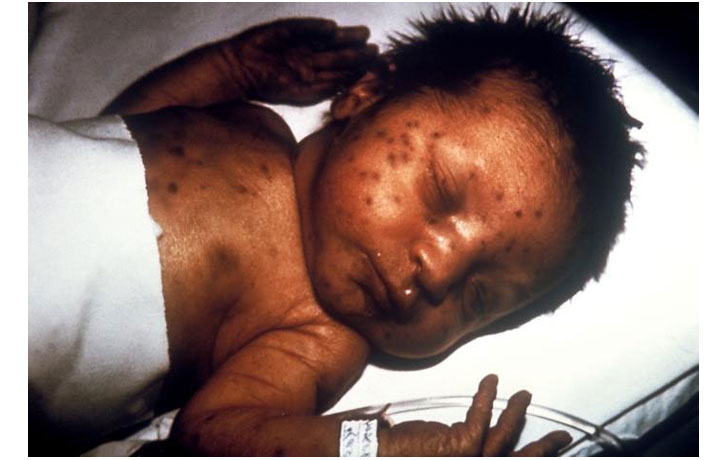
Rubella
Rubella, also known as the German measles, is a viral infection characterized by an erythematous maculopapular or morbilliform rash that typically begins on the face and head and generalizes over 24 hours i.e. it spreads downwards towards the trunk and limbs. It is often called the 3 day measles because the rash lasts about 3 days. The rash may be itchy and is accompanied by a low fever and enlargement of lymph nodes in the post-auricular, sub-occipital, and posterior cervical regions (behind the ears, head, and neck).
In children, the rash is often the first sign, whereas in adults, the lymphadenopathy and other non-specific symptoms (headache, malaise, cough, conjunctivitis) may precede the rash by 1-5 days. These prodromal symptoms may last for several weeks.
| Alternate Names | German measles, 3 day measles |
| Pathogen | Rubella virus is part of the togavirus family. It is enveloped, SS + linear and icosahedral. |
| Transmission | Respiratory droplets |
| Rubella presentation | Fever, enlarged post-auricular and sub-occipital lymph nodes, an erythematous morbilliform rash that starts on the face and head and spreads down towards the trunk and then limbs. Other symptoms include cough, conjunctivitis, arthralgia, headaches, malaise, and myalgia. |
| Congenital rubella syndrome (CRS) | Triad of – Congenital cardiac defects: PDA (continuous machine-like murmur), pulmonary artery hypoplasia/ stenosis, or septal defects – Cataracts – Deafness May also have “blueberry muffin” rash ( due to extramedullary hematopoiesis, specifically dermal erythropoiesis), cleft palate, hemolytic anemia, mental retardation, cerebral palsy, growth retardation, blindness, and glaucoma. |
| Prevention | MMR (measles, mumps, rubella) live attenuated vaccine. May also be given MMRV (includes varicella). |
| Complications | Encephalitis: 1/50,000 Late progressive panecephalitis Neuritis Orchitis Thrombocytopenia: 1/3,000 |
Congenital Rubella Syndrome (CRS)
Maternal infection with rubella can lead to congenital rubella syndrome (CRS) resulting congenital fetal defects. This is most likely to occur during the first trimester. The likelihood is about 85% during the first trimester but drops to 54% during the early second trimester and to 25% by the end of the second trimester. The risk during the third trimester is much lower.

Review Questions
- When can the live attenuated MMR vaccine be given to pregnant women?
- Live attenuated vaccines can be given from 3 months before conception and during the pregnancy. This time is critical for development (same reason why prenatal vitamins should be started 3 months before conception and taken throughout pregnancy)
- If MMR vaccine has not been given during childhood, then it can be given 3 months before conception or after delivery. Once the vaccine is given, pregnancy should be avoided for at least 3 months.
- When is maternal infection with rubella most likely to lead to birth defects in the fetus? First, Second, or Third trimester?
- First trimester is when the fetus is most at risk as most organogenesis occurs during this period
- Should pregnant women be tested for immunity to rubella? If she is not immune, what should be done?
- Yes, pregnant women need to be tested for rubella immunity during pregnancy. If not immune, then the live attenuated vaccine is given in the immediate postpartum period.
- A pregnant women is tested for rubella immunity/ susceptibility and is found to have 4 IU/mL rubella IgG antibodies. Is she susceptible?
- Yes, she is because she has ≤5 IU/ml making her non-reactive
- Non-reactive (0-5 IU/mL) – insignificant level of rubella IgG antibody
- Equivocal (6-10 IU/mL) – rubella IgG antibody level is “intermediate”
- Reactive (>10 IU/mL) – rubella IgG antibodies present
- A pregnant women is not immune to rubella is exposed during her pregnancy. Is giving immune globulin (Ig) after exposure routinely recommended?
- No, it is not because it does not prevent infection
- What test(s) can be done to confirm rubella infection?
- Rubella IgG seroconversion
- Reball RNA detection by RT-PCR – a nasopharyngeal/ throat swab or urine sample
- Rubella virus isolation
Resources & Attributions


